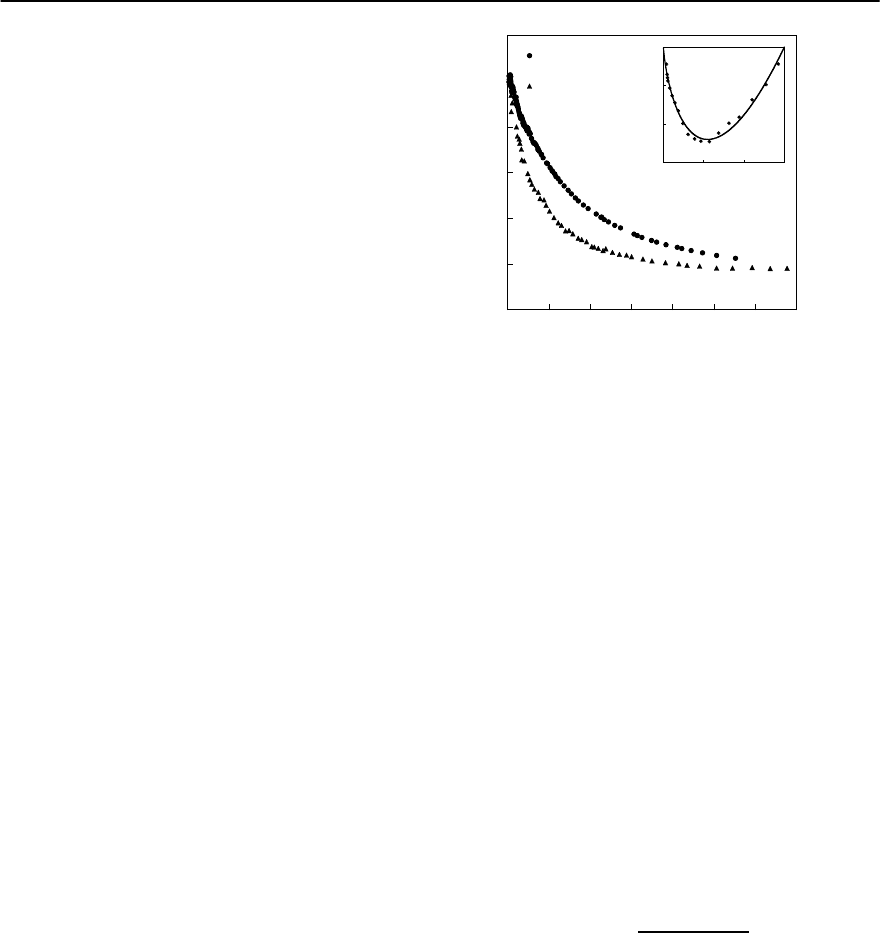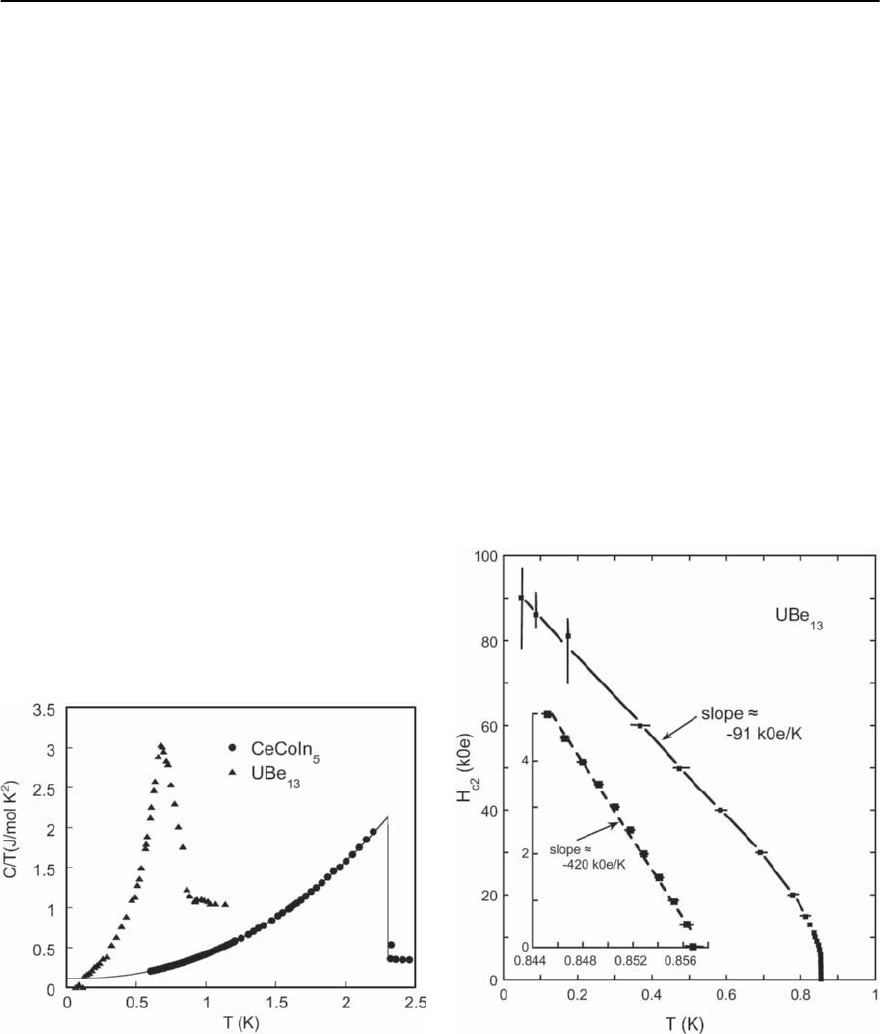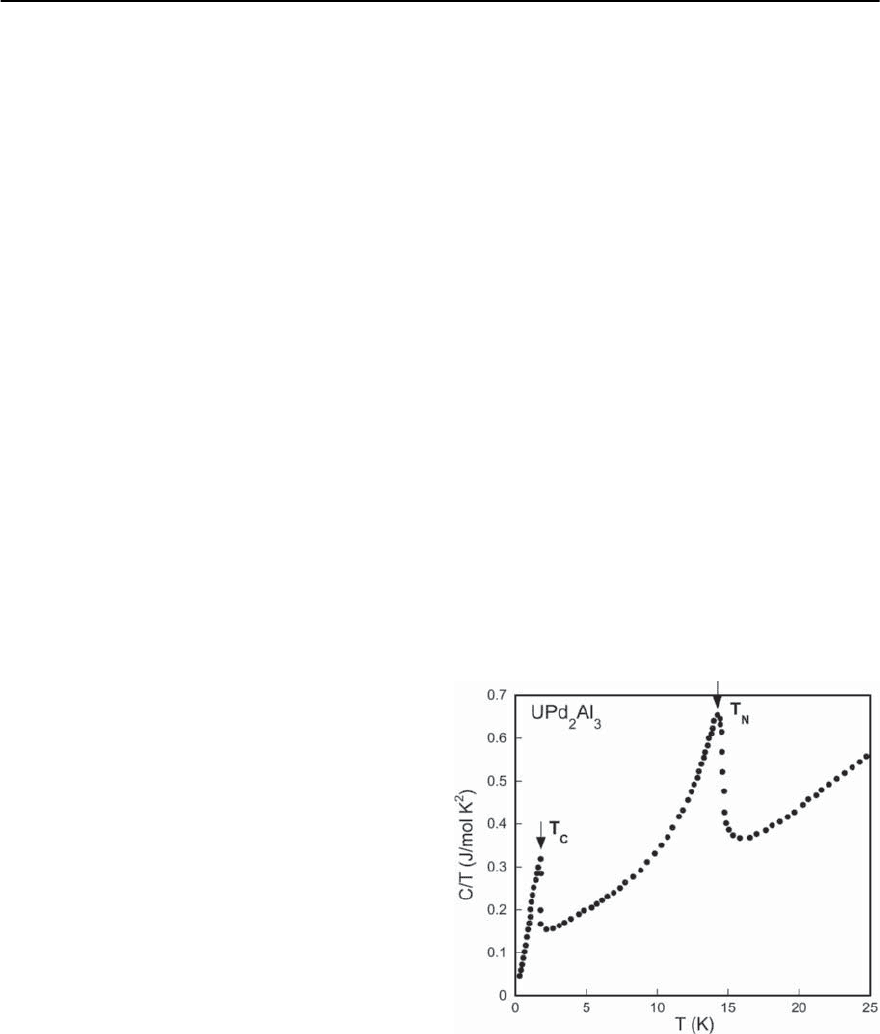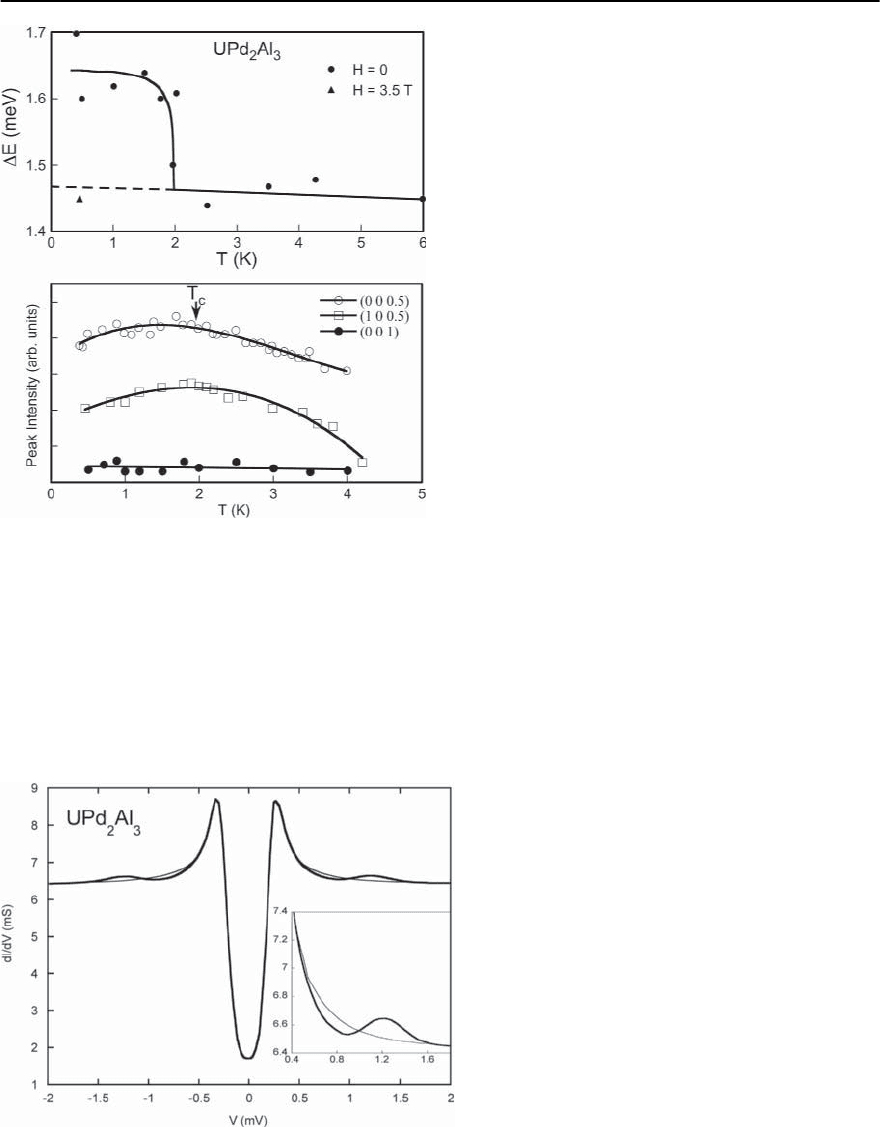Bennemann K.H., Ketterson J.B. Superconductivity: Volume 1: Conventional and Unconventional Superconductors; Volume 2: Novel Superconductors
Подождите немного. Документ загружается.


13 Unconventional Superconductivity in Novel Materials 661
serves as an example to illustrate how various spec-
troscopic techniques have been used to elucidate the
nature of heavy-fermion superconductivity.
13.3.2 Normal-State Properties
Specific Heat
For most metals, the normal-state specific heat C at
low temperatures can be described by the sum of an
electronic contributionthat varies linearly with tem-
perature T, and a phonon term that varies as T
3
, i.e.,
C(T)= T + ˇT
3
. (13.16)
This equation is validfor temperatures well belowthe
Fermi and Debye temperatures. Due to significant
correlations between electrons at the Fermi-surface,
the physics of heavy-fermion materials is most ef-
fectively described in terms of quasiparticle excita-
tions. The effective mass of these quasiparticles can
be much larger than that of free electrons,and is pro-
portional to the electronic specific heat coefficient
= C/T.
For an ordinary metal, is close to the value
for a free-electron gas
0
=(
2
/3k
2
B
)N(E
F
), where
N(E
F
) is the density of states at the Fermi Energy;
e.g., for sodium, /
0
≈ 1.3. In heavy-fermion com-
pounds, /
0
can range from 10–1000. In these ma-
terials, strong electronic or magnetic correlations
between the electrons at the Fermi surface lead to
high effective masses up to several hundred times
the free-electron mass. The effective mass is propor-
tional to the density of states at the Fermi energy,
and therefore to the specific heat coefficient .Val-
ues of (T = 0) for various heavy-fermion materials
are shown in Table 13.2.
For many heavy-fermion compounds, C(T)de-
viates from Eq. (13.16) at low temperatures, such
that (T)=C(T)/T increases with decreasing tem-
perature, sometimes reaching a maximum. The spe-
cific heat of the heavy-fermion compounds UBe
13
and CeCu
2
Si
2
, plotted as C/T vs T
2
are shown in
Fig.13.22.Thevalueof of both compoundsdiverges
at temperatures below ∼ 4K,reachingavalueof1
J/mol K
2
as T approaches 0 K.This may be an indica-
tion of NFL behavior,to be discussed in Sect. 13.3.6,
0
0.2
0.4
0.6
0.8
1
1.2
0 10203040506070
CeCu
2
Si
2
UBe
13
K lom/J( T/C
2
)
T
2
(K
2
)
UPt
3
0.3
0.35
0.4
0.45
0 100 200 300
Fig. 13.22. Normal-state specific heat C(T) plotted as C/T
vs T
2
for CeCu
2
Si
2
(circles) [108] and UBe
13
(triangles)
[136]. The inset shows C/T vs T
2
for the compound UPt
3
[137], where the solid line is a fit to Eq. (13.17)
or a low effective Fermi temperature, below which
the density of states at the Fermi energy increases.
For the heavy-fermion systems UPt
3
and UAl
2
,the
specific heat at low temperatures canbe describedby
C(T)= T + ıT
3
ln T + ˇT
3
(13.17)
for T < 20 K. The additional ıT
3
ln T term was first
observed in
3
He [171], and is predicted [172,173]
for long range spin fluctuations. The specific heat of
UPt
3
is shown in the inset to Fig. 13.22, where the
solid line is a fit to Eq. (13.17).
Magnetization
The magnetic susceptibility in heavy-fermion sys-
tems tends to follow a Curie–Weiss law at high tem-
peratures
(T)=
N
A
2
eff
3k
B
(T −
CW
)
, (13.18)
where N
A
is Avogadro’s number, k
B
is Boltzmann’s
constant,
eff
is the effective magnetic moment, and
CW
is the Curie–Weiss temperature. The effective
moment is often reduced somewhat with respect to
the free ion value of the rare earth or actinide ion,
which can be attributed to valence fluctuations, the
Kondo effect, or crystalline electric field effects. The

662 M.B. Maple et al.
Table 13.2. Normal-state properties of heavy-fermion superconductors at ambient pressure, unless noted otherwise.
is the electronic specific-heat coefficient at low temperatures, taken at T
c
. % (300 K) and %
0
are the room temperature
and low temperature resistivities, respectively. T
M
is the magnetic ordering temperature at ambient pressure. The order
type refers to antiferromagnetism (AFM), ferromagnetism (FM) or spin density wave (SDW). T
coh
is the temperature at
which the screening of local moments by the Kondo effect reduces magnetic scattering, and is determined from a gradual
shoulder or maximum in the electrical resistivity.
Compound
300K
0
T
M
Order T
coh
(mJ/mol K
2
)(ܤ cm) (ܤ cm) (K) type (K)
CeCu
2
Si
2
700 [108] 90 [138] 4.8 [139] 0.8 [140] SDW 20 [138]
CePd
2
Si
2
47 2 [141] 10 [142] AFM
CeRh
2
Si
2
80 17 6
a
35 [143] AFM
CeNi
2
Ge
2
350 [112] 14/16 2.6/0.9 [144] 50 [145]
CeCu
2
Ge
2
225
b
120
b
[146] 4.15 [147,148] AFM
CeIn
3
0.7 [149] 10.1 AFM 50 [150]
CeRhIn
5
200
c
[151] 33
c
< 1 3.8 AFM 25
c
[115]
CeIrIn
5
720 40 1.25 50 [116]
CeCoIn
5
290 17 3 30 [117]
Ce
2
RhIn
8
∼400
a
[152] 70 65 2.8 AFM 10
a
[118]
CePt
3
Si 390 [119] 90 5 2.2 AFM 90
CeRhSi
3
120 [120] 75 [153] 0.4 1.6 AFM
CeIrSi
3
120 [120] 140 [154] 1.4 5.0 AFM ∼ 200
CeNiGe
3
40 [121] 250 [155] 1.5 5.5 AFM ∼ 120
Ce
2
Ni
3
Ge
5
90 [156] 180 [157] 1.9 4.8/4.2 [156] AFM ∼ 100
PrOs
4
Sb
12
350
d
[123,158] 200 6
UBe
13
900 [159] 140 200 [136] 10
UPt
3
420 [160] 225/100 [161] 0.5 6 [162] AFM 10
URu
2
Si
2
65 [126,163] 330/170 30/30 [164] 17.5 AFM 50
UPd
2
Al
3
150 [127] 140 10 14 AFM 75
UNi
2
Al
3
120 [128] 1000 25 4.5 SDW 100
UGe
2
30 [165,166] 200 0.2 53 FM
UIr 40 [167] 110 [168] 0.44 47 FM
URhGe 160 [169] 2 [109] 10 FM
U
6
Fe 280 [170] 50
PuCoGa
5
80
d
[133] 250 20
PuRhGa
5
50
d
[134] 260 25
a
7.3kbar
b
160 kbar
c
16 kbar
d
determined from normal and superconducting-state properties.

13 Unconventional Superconductivity in Novel Materials 663
Curie–Weiss temperature is generally large and neg-
ative due to valence fluctuations or Kondo interac-
tions if the temperature range of the Curie–Weiss
fits is much larger than the CEF splitting of the lan-
thanide or uranium f -electron energy levels.
CW
is
found to be a rough measure of the Kondo tempera-
ture, i.e., T
K
∼ (3 − 4)
CW
.
At low temperatures (e.g. ∼ 50 K for CeMIn
5
(M
= Co, Rh, Ir), 300 K for UPt
3
) the magnetic suscep-
tibility (T) typically deviates from a Curie–Weiss
law. The direction of this deviation varies from com-
pound to compound. For example, UPt
3
has a larger
susceptibility at low temperatures than is predicted
by the Curie–Weiss law,whereas UBe
13
has a smaller
susceptibility. There are various mechanisms which
could be responsible for these deviations, including
CEF effects, magnetic ordering, quenching of the lo-
cal moments by the Kondo effect (which would only
explain a suppression of the magnetization),and va-
lence fluctuations.
The Pauli susceptibility of heavy-fermion materi-
als at the lowest temperatures, (0), is much larger
than that of ordinary metals, typically by a factor of
10–100.It is empirically found[174] to scale with the
electronic specific heat coefficient (0). In Fig.13.23,
(0)isplottedasafunctionof(0)for variousheavy-
fermion materials. This scaling of the magnetic sus-
ceptibility and the electronic specific heat coeffi-
cient is predicted by Wilson for Kondo systems [175]
where the Wilson–Sommerfeld ratio
R =
2
k
2
B
2
eff
(0)
(0)
(13.19)
is on the order unity for most heavy-fermion com-
pounds. The predictions give R = 1 for the nonin-
teracting electron model, and R = 2 for the Kondo
model [175]. In a more general context the Wilson
ratio is also known as the Sommerfeld ratio.
Many heavy-fermion superconductors order an-
tiferromagnetically (e.g., UPd
2
Al
3
, CeIn
3
)orexhibit
spin glass freezing at low temperatures, and a very
small number also order ferromagnetically (e.g.,
UGe
2
). The magnetic ordering temperatures of all
the heavy-fermion superconductors are listed in Ta-
ble 13.3. The heavy-fermion compounds that or-
der antiferromagnetically fall into two classes. Com-
Fig. 13.23. Electronic specific heat coefficient plotted as a
function of magnetic susceptibility at low temperatures
ona log–logscale forvarious heavy-fermion materials.The
solid line is the free-electron prediction for the Wilson ratio
(R = 1),after [174]
pounds in the first class (e.g., UPd
2
Al
3
,UNi
2
Al
3
,
CeIn
3
and CeRhIn
5
) have ordered magnetic mo-
ments in the range (0.2−1)
B
, and appear to have
standard dipolar order parameters. Compounds in
the second class (URu
2
Si
2
and UPt
3
)haveverysmall
ordered moments (∼ 0.01
B
), although the N´eel
temperatures of these compounds are comparable
to those of the first class. One possible explanation
for these small moments is quadrupolar ordering, al-
though only the dipolar moment has been detected
by means of neutron scattering experiments. In UPt
3
and U
1−x
Th
x
Be
13
, an additional tiny (0.001
B
)mag-
netic moment is associated with the onset of a second
superconducting phase.
Electrical Resist ivity
The electrical resistivity of heavy-fermion mate-
rials is remarkably different than that of conven-
tional metals. For a typical metal, (e.g., Cu), the re-
sistivity decreases with decreasing temperature due
to electron–phonon scattering for T >
D
,where
D
is the Debye temperature. At low temperatures,
Fermi liquid theory predicts that (T) saturates as
(T) ∝ AT
2
∝ (T/T
F
)
2
, with a coefficient A of the

664 M.B. Maple et al.
Table 13.3. Magnetic properties of some heavy-fermion superconductors.
CW
and
eff
are Curie–Weiss fit parameters to
the susceptibility at high temperatures, and
ord
is the ordered moment determined from neutron diffraction.
(H parallel/perpendicular to c-axis)
Compound (0)
CW
eff
ord
(cm
3
/mol) (K) (
B
)(
B
)
CeCu
2
Si
2
0.082 140 2.68 [176]
CeNi
2
Ge
2
> 0.009 170 2.6 [145]
CeCu
2
Ge
2
0.3 [113]
CeRhIn
5
0.022/0.005 16/−79 2.38 [115] 0.75 [177]
CeIrIn
5
0.018/0.009 12.5/−67 2.28 [116]
CeCoIn
5
0.014/0.008 −83/−54 2.59 [117]
Ce
2
RhIn
8
0.013/0.016 12/−40 2.38/2.32 0.55 [178]
CePt
3
Si 0.013/0.012 [179] −45/−75 2.67/2.75 0.16 [180]
CeRhSi
3
0.095 [120] –128 2.65
CeIrSi
3
0.032/0.062 [154] –186/−109 2.57/2.64
CeNiGe
3
0.08 –12 2.58 0.8 [121]
Ce
2
Ni
3
Ge
5
0.044 [156] −52 2.5 0.4 [122]
PrOs
4
Sb
12
0.06 [123] −16 3.0
UBe
13
0.015 [174] −53 3.1
UPt
3
0.19/0.10 [181] −200 3.0 0.01 [182]
URu
2
Si
2
0.01/0.06 −65 3.5 0.03 [126]
UPd
2
Al
3
0.015 [127] −47 3.2 0.85 [183]
UNi
2
Al
3
0.023/0.055 [128,184] 0.2 [185]
UGe
2
55 [3] 2.7 1.5 [165]
UIr –31 2.91 [167] 0.5 [168]
URhGe 10 [109] 1.8 0.42 [131]
U
6
Fe 0.003 [186]
PuCoGa
5
0.031 −2 0.68 [133]
PuRhGa
5
0.0015/0.0013 −132/−160 0.85 [134,187]
order of 10
−6
ܤ cm/K
2
.ThisAT
2
term is so small
in simple metals that it is often obscured by other
electron scattering processes. In heavy-fermion ma-
terials on the other hand, the AT
2
term can be up
to five orders of magnitude larger than in ordinary
metals, reflecting a low effective Fermi temperature
T
∗
F
∼ 10–100 K, and is often observed at low tem-
peratures. A universal relation between the large
magnitude of A and the enhanced electronic spe-
cific heat coefficient in heavy-fermion materials
was found by Kadowaki and Woods [188]. They ob-
served that most HF compounds obeyed the relation
A/
2
=1× 10
−5
ܤ cm (mol K/mJ)
2
,asillustrated
in Fig. 13.24, provided the materials are not too close
to a magnetic instability.Displayed in Fig. 13.25 are
the (T) curves for two typical heavy-fermion com-
pounds UBe
13
and CeAl
3
.The resistivity of these and
many other heavy-fermion materials is of the order
of 100‹§cm near room temperature, some 10−100
times that of normal metals, and reflects the large
exchange (Kondo) interaction between the local mo-
ments and the conduction electrons.A weak temper-
ature dependence of (T) is most often observed in
these materials at higher temperatures, followed by

13 Unconventional Superconductivity in Novel Materials 665
Fig. 13.24. Kadowaki–Woods plot: coefficient of the T
2
term in the electrical resistivity A vs electronic specific
heat coefficient . The line has a slope A/
2
=1×
10
−5
ܤ cm (mol K/mJ)
2
, after [188]
Fig. 13.25. Electrical resistivity vs T of the heavy-fermion
compounds UBe
13
and CeAl
3
. Inset: vs T
2
for CeAl
3
at
low temperatures, after [136,189,190]
amaximumorshoulderatT
coh
∼ 50–100 K. The
resistivity drops rapidly just below T
coh
due the for-
mation of coherent Bloch states as the lattice of the
local moments of the f -ion sublattice is screened
by the conduction electrons. At the lowest tempera-
tures, the resistivity exhibits Fermi liquid properties,
0
+AT
2
,as shown in the inset of Fig.13.25 for CeAl
3
.
A departure from the T
2
behavior of the electrical
resistivity at low temperatures is observed in some
heavy fermion materials, and is referred to as non-
Fermi liquid behavior. This is discussed in detail in
Sect. 13.3.7.
Thermoelectric Pow er
The thermoelectric power S is a sensitive function
of the shape of the density of states near the Fermi
level; therefore, large values of S are often observed
in heavy-fermion compounds, compared to those of
simple metals, due to the presence of a narrow f or
d-band at the Fermi level.A simple expression for the
thermopower due to electron diffusion, that is valid
for T
D
,isgivenby
S =
2
k
2
B
T
3e
d(ln (E))
dE
E
F
, (13.20)
where (E) is the value of the conductivity of the ma-
terial at an energy E.AmaximuminS is expected at a
temperature of the order of the Kondo temperature.
An anomalously large and positive value of S is often
observed for Ce-based heavy-fermion compounds,
with a maximum centered at T
K
or at the CEF split-
ting if CEF effects are present. For Yb-based heavy-
fermion materials, S is usually large and negative re-
flecting the fact that the electronic configuration of
Yb is the one-hole counterpart to the one-electron
configuration of Ce.
13.3.3 Superconducting-State Properties
Specific Heat
The specific heat in the superconducting state of
heavy-fermion materials differs markedly from that
of conventional superconductors. Whereas C(T)in
a conventional superconductor varies as C(T) ∝
exp(−/k
B
T), in accordance with BCS theory, the

666 M.B. Maple et al.
specific heat of heavy-fermion materials can often
be described by a power-law
C(T)=
0
T + ıT
n
, (13.21)
where the power-law exponent n ∼ 2−3. Both the
residual specific heat
0
and the power law behav-
ior suggest an unconventional superconducting gap
that vanishes at lines (n =2)orpoints(n =3)onthe
Fermi surface.
In heavy-fermion materials, the magnitude of the
specific heat jump C at T
c
is a large fraction of the
value of C(T
c
). Values of C/ T
c
are listed in Ta-
ble 13.4. The quantity C/ T
c
is predicted by BCS
theory to be 1.43 (weak coupling) or 1.6 (strong cou-
pling). The fact that C/ T
c
for heavy-fermion ma-
terialsisoftheorderofunity,where is the value
derived from the normal-state specific heat, implies
that the superconductivity in these materials is a
bulk phenomenon, and that the same electrons re-
sponsible for the heavy-fermion behavior in the nor-
mal state are participating in the superconductivity.
The specific heat jumps for the compounds UBe
13
and CeCoIn
5
are shown in Fig. 13.26. For CeCoIn
5
,
the specific heat jump is unusually large such that
C/ T
c
=4.5−5 [116,191]; in addition C(T)below
T
c
can be fit by Eq.(13.21) with n =2.3and
0
= 110
mJ/mol K
2
.
Fig. 13.26. Superconducting jump in the specific heat plot-
ted as C/T vs T of UBe
13
(triangles) [136] and CeCoIn
5
(circles) [191]. The line below T
c
is a fit to Eq. (13.21)
C = T + ıT
n
Upper Critical Field
All of the known superconducting heavy-fermion
compounds are type-II superconductors with upper
critical fields H
c2
of the order of a few tens of kOe
and lower critical fields H
c1
of the order of tens of
Oe, corresponding to values of ≡ /
0
∼ 50 − 100,
where is the penetration depth and
0
is the super-
conducting coherence length. These unusually large
values of H
c2
and small values of H
c1
reflect the large
effective masses of the superconducting quasiparti-
cles which can be understood by noting that H
c1
∝
1/
2
∝ 1/m
∗
and H
c2
∝ 1/
2
0
∝ m
∗2
.Mostheavy-
fermion superconductorshave a large initialslope of
the upper critical field near T
c
,−(dH
c2
/dT)
T
c
,and
sometimes exhibit a linear T-dependence at lower
temperatures. For example, the initial slope of UBe
13
is enormous, −(dH
c2
/dT)
T
c
= 420 kOe/K [136], as
shown in the inset of Fig. 13.27. Below T =0.6K,
the upper critical field of UBe
13
is linear in tempera-
ture with a slope of −91 kOe/K (Fig. 13.27). The zero
Fig. 13.27. Upper critical field H
c2
vs T of UBe
13
. Inset:Ex-
panded view of H
c2
(T)ofUBe
13
near T
c
. The line is a fit
to the data yielding a slope −(dH
c2
/dT)
T
c
= 420 kOe/K,
after [136]

13 Unconventional Superconductivity in Novel Materials 667
temperature value of the orbital critical field can be
estimated from the initial slope of the upper critical
field by the following formula [203]:
H
∗
c2
(0) = 0.693T
c
(−dH
c2
/dT)
T
c
, (13.22)
from which the superconductingcoherence length
0
can be determined from the relation [204]
H
∗
c2
(0) = ¥
0
/2
2
0
, (13.23)
where ¥
0
=2.07 × 10
−7
Oe cm
2
is the flux quan-
tum. The value of
0
can be used to estimate the
Fermi velocity from the relation
0
∝ 0.18v
F
/kT
c
;
thus, the effective mass can be obtained via m
∗
=
k
f
/v
F
within a spherical-Fermi-surface approxi-
mation. The values of the coherence length and
the effective mass estimated in this fashion for the
heavy-fermion superconductors are collected in Ta-
ble 13.4. Many heavy-fermion superconductors have
anisotropic upper critical fields of the order of
H
||
c2
/H
⊥
c2
≈ 1.5nearT
c
(with respect to the c -axis).
Heavy Fermion Superconducting Properties Section
The spin susceptibility
s
in the superconducting
state determined from Knight shift measurements is
sensitive to the symmetry of the superconducting or-
der parameter.For spin-singlet (even parity) pairing
(in the absence of spin-orbit coupling),
s
decreases
below T
c
, while for spin-triplet (odd parity) pairing,
the spin susceptibility remains constant (for certain
directions).For nearly all of the heavy fermionsuper-
conductors,a decrease in
s
belowT
c
is observed (the
notable exception is UPt
3
), implying that the spin
partof the Cooperpairwavefunctionisa spin-singlet
(anti-symmetric under particle exchange). Since the
orbital part of the wavefunction must then be sym-
metric to satisfy the Pauli exclusion principle, the
total angular momentum in these materials is even,
i.e., L =0, 2,...(s-wave,d-wave,...).Spin-latticere-
laxation (1/T
1
) measurements that probe the shape
of the density of states in the superconducting state
have been used to distinguish between these two sce-
narios. For conventional s-wave superconductors, a
Hebel-Slichter peak at T
c
and an exponential tem-
perature dependence of 1/T
1
ispredicted[Tinkham],
while no Hebel-Slichter peak and a power law T-
dependence is expected for an unconventional su-
perconductor (either T
3
for line nodes or T
5
for point
nodes). A T
3
dependence of 1/T
1
is generally found
in the heavy fermion superconductors indicating a
d-wave superconducting order parameter.
13.3.4 UPd
2
Al
3
Introduction
The heavy-fermion compound UPd
2
Al
3
belongs to
the ever-growing class of materials which display the
coexistence of antiferromagnetic order and super-
conductivity at low temperatures. This class, which
includes such compounds as UPt
3
and CeIn
3
,hasat-
tracted considerable attention during the last decade
due to the unusual nature of the superconductivity.
The detailed nature of the superconductivity in these
compounds has been investigated using an assort-
ment of optical and spectroscopic techniques includ-
ing NMR,Josephson tunneling,andinelastic neutron
scattering,which suggests that the superconductivity
is magnetically mediated and has d-wave order pa-
rameter symmetry. In this section, we use UPd
2
Al
3
as an example to illustrate how spectroscopic tech-
niques have been used to elucidate the nature of
heavy-fermion superconductivity.
Fig. 13.28. Specific heat divided by temperature C/T plot-
ted vs temperature T of polycrystalline UPd
2
Al
3
.TheN´eel
temperature T
N
and superconducting transition tempera-
ture T
c
are indicated, after [127]

668 M.B. Maple et al.
Table 13.4. Superconducting properties of heavy-fermion superconductors. T
c
: superconducting transition temperature
at P
c
; H
c2
: upper critical field at T =0K;−(dH
c2
/dT)
T
c
: slope of the upper critical field; m
∗
: effective mass deter-
mined from H
c2
as discussed in Sect. 13.3.3; C/ T
c
: superconducting specific heat jump C/T
c
divided by electronic
specific heat coefficient ;
0
: superconducting coherence length determined from Eq. (13.22). Values are listed as H
parallel/perpendicular to the c-axis
Compound T
c
P
c
H
c2
(0) −(dH
c2
/dT)
T
c
0
C/ T
c
m
∗
(K) (kbar) (kOe) (kOe/K) (Å) (m
e
)
CeCu
2
Si
2
0.49 [108] 20/25 230/230 [138] 65 351 [192]
CePd
2
Si
2
0.43 28 [142] 13/7 16/12.7 [193] 230/300 97
CeRh
2
Si
2
0.4 6 35 13 307 118 [194]
CeNi
2
Ge
2
0.23 23 > 15 5 [144] 642 75
CeCu
2
Ge
2
∼ 2 165 [195] 35 11 [146] 147 37
CeIn
3
0.17 25 [2] 4.5 [196] 32 300 191
CeRhIn
5
2.17 16 [115] 160 [151] 140 [115] 40 0.36 [151] 104
CeIrIn
5
0.40 5/9 24/48 223/141 0.76 [116] 100
CeCoIn
5
2.3 [117] 50/120 7/15 [197] 50/32 4.5 [117] 121
Ce
2
RhIn
8
2 [118] 23 −/54 −/92 51 94
CePt
3
Si 0.75 [119] 28/34 [179] 75/57 95/109 0.25 [119] 140
CeRhSi
3
1.0 [153] 20 70 120 62 140
CeIrSi
3
1.6 [154] 25 111 114 51 105
CeNiGe
3
0.48 [155] 65 23 71 118 120
Ce
2
Ni
3
Ge
5
0.26 [157] 36 8 45 200 145
PrOs
4
Sb
12
1.85 [123] 22 19 116 ∼ 3 [158] 44
UBe
13
0.85 90 [198] 420 [198] 37 1.23 [136] 351
UPt
3
0.55 [199] 18 63 117 0.5−1.0 [160] 265
URu
2
Si
2
1.5 [126,163] 100 92 59 0.56 184
UPd
2
Al
3
1.9 30 43 76 [200] 1.2 [127] 187
UNi
2
Al
3
1.0 10 13 191 [200] 0.4 [128] 147
UGe
2
0.7 [3,201] 10 20 58 [202] 108 [202] 0.25 235
UIr 0.14 [168] 26 0.26 3 1063 137
URhGe 0.3 [109] 7 40 199 0.5 281
U
6
Fe 3.7 [170] ∼ 100 34 61 ∼ 2 109
PuCoGa
5
18.5 [133] ∼ 1270 99 16 ∼147
PuRhGa
5
8.7 [134] ∼ 270 20/35 52/40 ∼140
UPd
2
Al
3
is a heavy-fermion compound with an
electronic specific heat coefficient of ≈ 100
mJ/mol K
2
, which corresponds to an effective elec-
tron mass of m
∗
≈ 50 m
e
. The specific heat of
UPd
2
Al
3
reveals antiferromagnetic order at T
N
=14
K, and superconductivity at T
c
=2K,asshownin
Fig. 13.28.

13 Unconventional Superconductivity in Novel Materials 669
Magnetic and Crystal Structure
Neutron diffraction measurements [205] show that
UPd
2
Al
3
crystalizes in the hexagonal PrNi
2
Al
3
struc-
ture with lattice parameters a =5.37 Å and c =
4.19 Å. The antiferromagnetic structure of UPd
2
Al
3
consists of ferromagnetic sheets in the easy hexag-
onal plane with a relatively large ordered magnetic
moment of 0.85
B
, which alternate along the c-axis.
The magnetism arises from localized uranium mo-
ments with practically no spin transfer from the Pd
ions, as confirmed by studies of neutron diffraction,
NMR, and band-structure calculations [206–208].
The first neutron diffraction measurements [209,
210] on UPd
2
Al
3
found that the AFM order remains
almost unchanged in the superconducting state.
However, recent high-resolution diffraction data in-
dicate [211] that as the temperature is lowered be-
low the superconducting critical temperature T
c
,a
small 1 % reduction occurs in the intensity of the
AFM Bragg peaks.
Inelastic Neutron Scattering
The inelastic neutron scattering profile measured at
the AFM wave vector Q =(0, 0, 0.5) is shown in
Fig. 13.29. In addition to the zero energy divergence
of the Bragg peak, two finite energy (inelastic) fea-
tures are evident in the data: a peak at E =1.5meV
due to the spin density wave, and a sharper peak at
E =0.36 meV which results from an energy gap in
the magnetic spectrum. The spin density wave is un-
usual in that it persists at temperatures well below T
N
.
It is localized about the AFM vector Q =(0, 0, 0.5),
since the peak intensity of the spin density wave peak
drops off rapidly away from Q.The orientationof the
spin density wave has been determined to be in the
a-b crystallographic plane, transverse to the sublat-
tice magnetization, from polarized inelastic neutron
scattering measurements [212].
The energy gap in the magnetic spectrum ob-
served in Fig. 13.29 occurs only in the supercon-
ducting state below T
c
=2KandH
c
=30kOe.The
temperature dependence of the gap is surprisingly
similar to the BCS theory prediction for a supercon-
ducting energy gap. At the lowest temperatures, the
Fig. 13.29. Inelastic neutron diffraction data for UPd
2
Al
3
at temperatures above and below T
c
=2K.Thelines are
guides to the eye,after [211]
energy gap extrapolates to 0.36meV, which corre-
sponds to 2 =2.2k
B
T
c
. This is comparable to the
weak-coupling BCS theory result of 2 =3.5 T
c
.The
appearance of this energy gap in the magnetic spec-
trum in the superconducting state suggests magnet-
ically mediated superconductivity.
Superconducting energy gaps at slightly larger
energies (up to 5.5k
B
T
c
) have been observed in
UPd
2
Al
3
by NMR [206,213,214]and electron tunnel-
ing [215] measurements. The discrepancy between
the results of the different techniques is probablydue
to anisotropy of the energy gap; the power-law be-
havior of the specific heat and 1/T
1
relaxation rate
from NMR measurements imply that the energy gap
in UPd
2
Al
3
should vanish at lines or points on the
Fermi surface.
The onset of superconductivity has a marked ef-
fect on the spin density wave peak in the neutron
diffraction data.As shown in Fig. 13.30, both the en-
ergy of the spin density wave peak and its line width
increaseabruptly atT
c
.At the same time,the intensity
of the peak reaches a maximum at T
c
,andthende-
creases at lower temperatures. These effects are only
apparent at fields below the critical field of UPd
2
Al
3
,
and the normal-state spin density wave reappears
above H
c2
. Thus, there appears to be a coupling be-
tween the superconducting and magnetic order pa-
rameters.

670 M.B. Maple et al.
Fig. 13.30. UPd
2
Al
3
inelastic neutron diffraction data [211].
Top pane l : Activation energy E of the spin density wave
peak vs T. Bottom panel:Maximumofthespindensity
wave peak vs temperature T at various wave vectors
A temperature T
0
, which characterizes the fre-
quency spread (line width) of the spin wave, can
be derived by fitting the energy spectrum to a
Lorentzian function, yielding T
0
≈ 28 K for UPd
2
Al
3
[217].Ithas been suggestedonthebasisof theoretical
work [216] that T
0
is proportional to T
c
for spin-wave
mediated superconductors[217].
Electron Tunneling
Further evidence for magnetically-mediated super-
conductivity in UPd
2
Al
3
, as well as details of the
symmetry of the order parameter, have been eluci-
dated by recent directional tunneling measurements
on thin films [218]. The UPd
2
Al
3
thin films, which
were grown by molecular beam epitaxy in the [001]
orientation, are separated from a thin film of Pb by
a 4 nm layer of aluminum oxide. Applying a mag-
netic field H = 300 Oe, which is above the H
c2
of Pb, but well below the H
c2
of UPd
2
Al
3
,results
in a superconductor-insulator-normal tunnel junc-
tion. The resulting tunneling spectrum is shown in
Fig. 13.31, where the thin line is a fit to the Dynes
formula. The most important feature of this tunnel-
ing spectrum is a peak at V =1.22 meV, which is
above the gap energy, and below typical phonon fre-
quencies (
D
≈ 150 K for UPd
2
Al
3
). The energy of
this feature is very close to the energy gap E =1.5
meV of a dispersive spin wave at the magnetic Bragg
point Q =(0, 0, 0.5), which was determined from in-
elastic neutron scattering measurements.Thus,these
measurements strongly suggest a coupling of the su-
perconducting order parameter to a spin-fluctuation
with an energy gap E =1.5 meV. Furthermore, the
Fig. 13.31. Normalized differential conductivity of a
UPd
2
Al
3
-AlO
x
-Pb tunnel junction. The thinner line is
a fit to the Dynes formula with = 235 ‹eV and
=35‹eV. The inset shows a feature associated with
strong-coupling spin-fluctuations,after [218]
